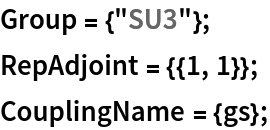Wolfram Language Paclet Repository
Community-contributed installable additions to the Wolfram Language
Computes 2-to-2 scattering matrix amplitudes for arbitrary quantum field theories
Contributed by: Andreas Ekstedt
Oliver Gould
Joonas Hirvonen
Benoit Laurent
Lauri Niemi
Philipp Schicho
Jorinde van de Vis
Computes 2-to-2 scattering matrix amplitudes for arbitrary quantum field theories

To install this paclet in your Wolfram Language environment,
evaluate this code:
PacletInstall["WallGo/WallGoMatrix"]
To load the code after installation, evaluate this code:
Needs["WallGo`WallGoMatrix`"]
We consider an SU(3) gauge theory in the adjoint representation, with Dynkin index {1,1}and representation dimension R = 8.
| In[1]:= |  |
No scalar fields are included in the model:
| In[2]:= |
Fermions are implemented as Weyl spinors. To construct one Dirac fermion, a left-handed and a right-handed Weyl fermion are combined:
| In[3]:= |  |
For QCD, we introduce six fermion generations (Nf = 6):
| In[4]:= | ![RepFermion3Gen = {RepFermion1Gen, RepFermion1Gen, RepFermion1Gen, RepFermion1Gen, RepFermion1Gen, RepFermion1Gen} // Flatten[#, 1] &;](https://www.wolframcloud.com/obj/resourcesystem/images/c2d/c2d03976-f5c0-4c58-a9fc-287fdf2643fc/4ff2905fd2ceecde.png) |
The input tensors defining the gauge interactions are then allocated via:
| In[5]:= |
Finally, the model is imported into the working environment using:
| In[6]:= |
We now define the particle content of the model using CreateParticle.
Representation for the top quark:
| In[7]:= |
| Out[7]= |
Representation for the gluon:
| In[8]:= |
| Out[8]= |
Representation for the five light quarks:
| In[9]:= |
| Out[9]= |
Out-of-equilibrium particles (e.g. heavy degrees of freedom such as the top quark and gluon) are collected as:
| In[10]:= |
Light particles, which are never incoming states, are collected separately:
| In[11]:= |
Generate a matrix element file truncated at leading logarithmic order, without exporting it to file.
| In[12]:= | ![MatrixElements = ExportMatrixElements[
None,
ParticleList,
LightParticleList,
{
TruncateAtLeadingLog -> True,
Format -> {"json", "txt"}
}
]](https://www.wolframcloud.com/obj/resourcesystem/images/c2d/c2d03976-f5c0-4c58-a9fc-287fdf2643fc/2ce79988f87aa484.png) |
| Out[12]= |  |
Generate a matrix element file that includes all contributions, without truncation at leading logarithmic order. When the option TagLeadingLog -> True is used, leading-logarithmic enhancements are additionally marked with logEnhanced tags in the output.
| In[13]:= | ![OutputFile = "matrixElements.qcd";
MatrixElements = ExportMatrixElements[
OutputFile,
ParticleList,
LightParticleList,
{
TruncateAtLeadingLog -> False,
TagLeadingLog -> True,
Format -> {"json", "txt"}
}
] // Collect[#, logEnhanced] &](https://www.wolframcloud.com/obj/resourcesystem/images/c2d/c2d03976-f5c0-4c58-a9fc-287fdf2643fc/730a53d89225300b.png) |
| Out[14]= |  |
Wolfram Language Version 13
GNU General Public License v3.0 or later